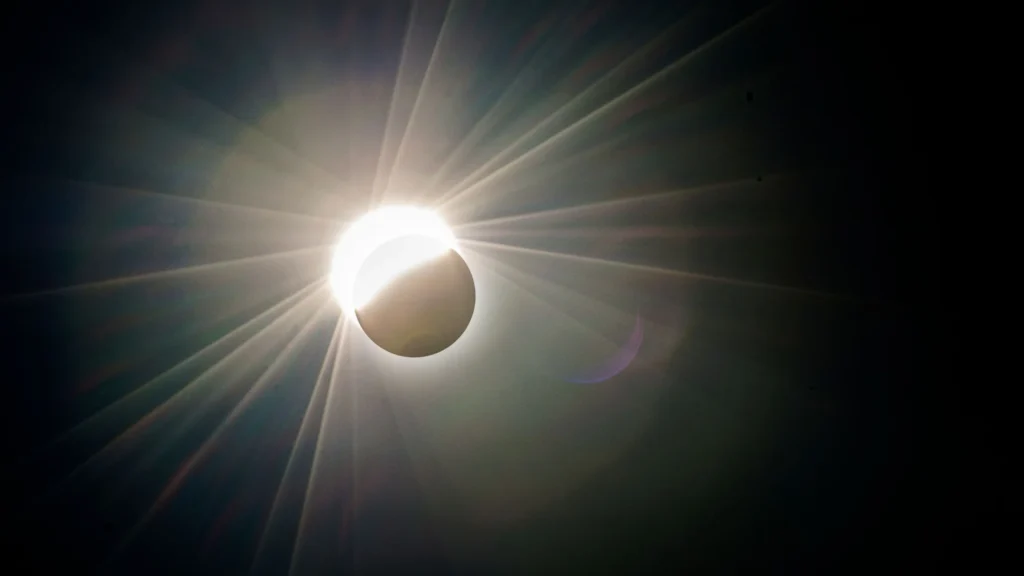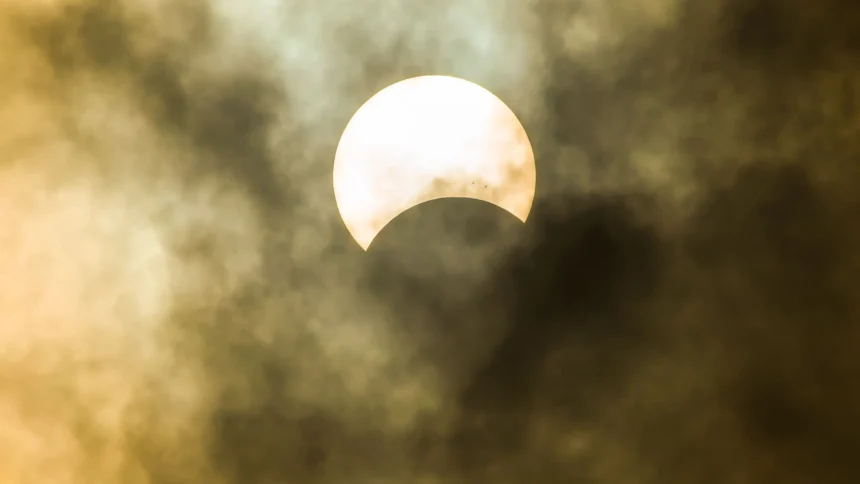Introduction
A rare celestial event will occur on March 29, 2025, when a partial solar eclipse will be visible in North America, allowing early risers to catch the moon taking a “bite” out of the sun at the time of sunrise. This happens when the moon moves between the Earth and the sun, blocking part of the sun’s light and casting a shadow on portions of the Earth.
Understanding the March 29 Solar Eclipse
A partial solar eclipse occurs when the moon partially blocks the sun, creating a crescent-like appearance. However, unlike total solar eclipses, where the sun is completely obscured, partial eclipses don’t block all sunlight and result in only a slight dimming of daylight. The extent of obscuration will depend on the observer’s position.
Read More: Don’t Miss the Total Lunar Eclipse 2025: Nature’s Epic Light Show
Best Viewing Across North America
The visibility and extent of the eclipse will vary depending on the areas:
- Northeastern United States: From northern Maine, where up to 85 percent of the sun will be obscured at sunrise. Observers in cities like New York and Boston will see the eclipse in progress as the sun rises, with maximum eclipse shortly afterward.
- Eastern Canada: In places such as Halifax and St. John’s, the eclipse will occur at sunrise, with about 83% of the sun masked.
- Greenland: In Nuuk, observers will see around 87% of the sun obscured by the moon at sunrise.
Time and Date’s interactive eclipse map and visibility guide.
Read More: Climate Change and Greenland Glacial Melt – 5 Alarming Effects
Optimal Viewing Times
The eclipse will start early, before sunrise in much of North America, making the event a rare treat, as observers will see a partially eclipsed sun rising over the horizon. The specific timing differs by location:
- Hartford, Connecticut: Sunrise at 6:38 a.m. EDT, the peak of the eclipse at 6:41 a.m., ends at 7:07 a.m.
- Maine’s Northernmost Point: Sunrise at approximately 6:15 a.m. EDT, and the eclipse will peak shortly afterward.

For exact timings based on your specific location, refer to local astronomy societies, or trusted online resources.
Read More: Why does Solar Eclipse Not Happen Every Month?
Safety Precautions
The first to witness a solar eclipse must do so with eye protection to avoid severe eye damage:
- Eclipse glasses: If you are watching the eclipse, make sure you use ISO-certified eclipse glasses or solar viewers. Ordinary shades will not suffice.
- Solar Filters for Equipment: If you are using specific equipment like cameras, telescopes, or binoculars, you will need specialty filters including solar filters for your lights.
Photographing the Eclipse
Taking clicks in the eclipse can be a rewarding experience:
- Solar Filters: Get solar filters to protect sensors and capture images.
- Use a Tripod: Keep your camera steady, as sunrise often happens in low light.
- Plan Your Composition: Identify clear eastern horizons to include foreground elements such as a landscape or cityscape, which will add context to your photographs.
Weather Considerations
For best viewing, you want clear skies:
- Monitor weather forecasts: Watch local forecasts in the run-up to the event.
- Pick Scenic View Places: Find sites with clear morning skies and low light pollution.
Read More: How Many Earths Can Fit in the Sun?
The March 29 Solar Eclipse: Something To Look Forward To
- March 29 Solar Eclipse: A rare partial eclipse at sunrise illuminating parts of North America, Canada, and Greenland. Unlike total eclipses, this will be a “figural” or “angular eclipse,” with the moon blocking a piece of the sun so that the eclipse will create a crescent sunrise.

- A Rare Sunrise Eclipse: The eclipse will be in progress when the sun rises, giving early risers a nice show as a partially obscured sun emerges from the horizon.
- Where to See It Best: The greatest obscuration will be seen from the northeastern U.S., eastern Canada, and Greenland with, for example, Maine and Newfoundland seeing as much as 85 percent of the sun covered up there.
- Unique Photography Opportunity: A sun low on the horizon and the progression of the eclipse itself make this a great event for beautiful astrophotography.
- Importance of Eye Protection: Eye protection is important. During the daytime, the sun will be a lot brighter, so ISO-certified eclipse glasses or solar filters are required for safe viewing.
- First Eclipse of 2025: This is the first solar eclipse of 2025, paving the way for the other upcoming eclipse.
Be sure to set your alarms and circle the date, you won’t want to miss this!
Read More: 7 Mind-Blowing Facts About Solar Atmospheres You Didn’t Know
Upcoming Eclipses
Here is a table of upcoming solar and lunar eclipses visible from North America:
| Date | Eclipse Type | Visibility in North America | Coverage | Best Viewing Locations |
| March 29, 2025 | Partial Solar Eclipse | Eastern USA, Canada, Greenland | Up to 85% | Northeastern USA, Eastern Canada |
| September 21, 2025 | Partial Solar Eclipse | Parts of North America | Up to 70% | Western and Central USA, Canada |
| March 3, 2026 | Total Lunar Eclipse | Entire North America | Total Eclipse | All of North America |
| August 12, 2026 | Partial Solar Eclipse | Northern USA, Canada | Up to 90% | Northwestern USA, Canada, Arctic |
| February 17, 2027 | Partial Lunar Eclipse | North America | Partial Eclipse | Entire North America |
| August 2, 2027 | Partial Solar Eclipse | Southern USA, Mexico | Up to 50% | Texas, Florida, Mexico |
| January 12, 2028 | Partial Solar Eclipse | Northern Canada, Alaska | Up to 70% | Alaska, Northern Canada |
| June 26, 2029 | Total Lunar Eclipse | Entire North America | Total Eclipse | All of North America |
| January 14, 2030 | Partial Solar Eclipse | Canada, Northern USA | Up to 80% | Northern USA, Canada |
Conclusion
While the March 29 Solar Eclipse is not only an astronomical spectacle, but a once-in-a-lifetime chance to see a rare sunrise eclipse in North America. The partially covered sun will rise above the horizon, leading to a crescent sunrise that is bound to be a visual treat for skywatchers. This is a spectacular opportunity to engage in the wonders of the universe.
The first solar eclipse of 2025 is upon us — and if you’re going to catch it, you’ll want to be prepared by scouting the best viewing spots, finding the proper eye protection, and setting up your camera gear. Be sure to catch this rarely occurring celestial event — you won’t see another one for a long time! 🌞🌙✨
FAQs
1. What is the March 29 Solar Eclipse?
The March 29 Solar Eclipse is a partial solar eclipse visible at sunrise across North America, Canada, and Greenland.
2. Where can I see the March 29 Solar Eclipse?
It will be best visible from the northeastern U.S., eastern Canada, and Greenland, with up to 85% sun coverage.
3. What time will the eclipse occur?
The eclipse will already be in progress at sunrise; exact timings vary by location—check local schedules.
4. How can I safely watch the eclipse?
Always use ISO-certified eclipse glasses or solar filters to protect your eyes from harmful sun exposure.
5. Will there be another eclipse soon?
Yes! A partial solar eclipse on September 21, 2025, and a total lunar eclipse on March 3, 2026.





